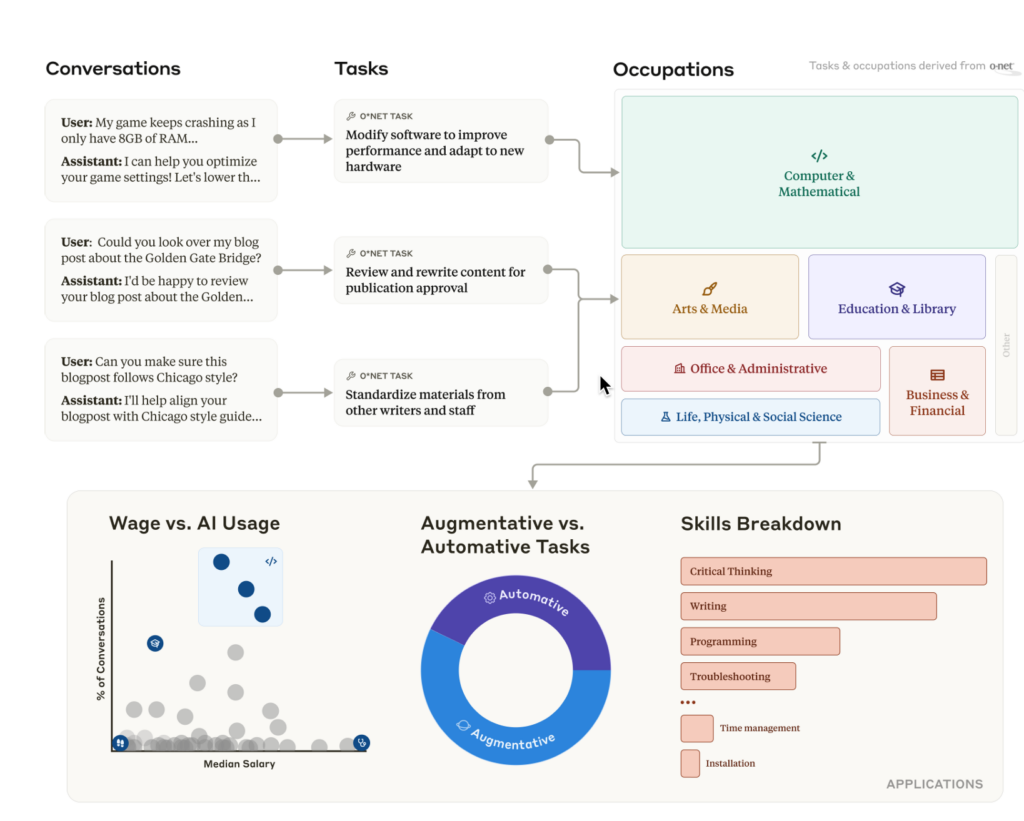Ever wondered how people are actually using AI in their daily work? Not the futuristic predictions or doomsday scenarios, but the real, day-to-day applications happening right now across different industries and roles. For the first time, we’re getting concrete data thanks to a groundbreaking study from Anthropic that analyzed over 4 million real conversations with their AI assistant Claude.
This isn’t just another speculative piece about AI’s potential impact – it’s hard data showing exactly how people are integrating AI into their work lives. Let’s dive into what they discovered.

A comprehensive view of how AI is being used in the workplace – from individual conversations to broader economic impacts. The visualization above breaks down actual usage patterns across different occupations, wage levels, and skill types.
The Big Picture: AI as Colleague, Not Replacement
Perhaps the most striking finding is that AI is primarily being used to enhance rather than replace human work. The study found that 57% of interactions showed people using AI as a collaborative tool – brainstorming ideas, getting feedback, or iterating on work together. Only 43% involved straightforward task automation.
Think of it like this: instead of AI taking over your job, it’s more like gaining a knowledgeable colleague who can help tackle tasks and spark new ideas.
Who’s Using AI and How?
The research revealed some fascinating patterns about which professions are adopting AI:
- Software development and technical writing lead the pack
- About 36% of occupations use AI for at least a quarter of their tasks
- Usage peaks in mid-to-high wage roles requiring bachelor’s degree-level preparation
- Both very high-wage positions (like physicians) and low-wage roles show relatively low usage
This suggests AI adoption isn’t just about technical capability – it’s about finding the sweet spot where AI can meaningfully augment human work without running into regulatory or physical-world limitations.
The Skills That Matter
When looking at which professional skills AI most commonly supports, the top performers were:
- Critical thinking
- Reading comprehension
- Writing
- Programming
- Active learning
Notably absent? Physical skills like equipment maintenance or installation, and interpersonal skills like negotiation. This helps explain why AI currently shows higher adoption in knowledge work versus hands-on or highly interpersonal roles.
What This Means for Kiwi Businesses
For New Zealand businesses, these findings offer valuable insights into how to approach AI adoption:
- Focus on Enhancement: Look for ways AI can augment your team’s capabilities rather than trying to automate entire roles.
- Start with Knowledge Work: The highest-value opportunities likely lie in areas involving analysis, writing, and information processing.
- Consider the Full Picture: Success with AI isn’t just about technical feasibility – consider regulatory requirements, physical constraints, and how it fits into existing workflows.
Looking Ahead
This research gives us our first real glimpse into how AI is being integrated into the workforce. Rather than the wholesale automation some predicted, we’re seeing a more nuanced picture where AI serves as a powerful tool to enhance human capabilities across a wide range of tasks.
For businesses considering AI adoption, the message is clear: focus on augmentation over automation, and look for opportunities where AI can complement rather than replace human skills.
What’s particularly exciting is that this is just the beginning. As AI capabilities continue to evolve and more businesses discover effective ways to integrate these tools, we’ll likely see even more innovative applications emerge.
Want to learn more about how AI could enhance your business operations? Contact us for a discussion about practical AI implementation strategies tailored to your needs.
Looking to stay ahead of the digital curve? Subscribe to our newsletter for the latest insights on AI, digital marketing, and business growth strategies.nce in more detail.
